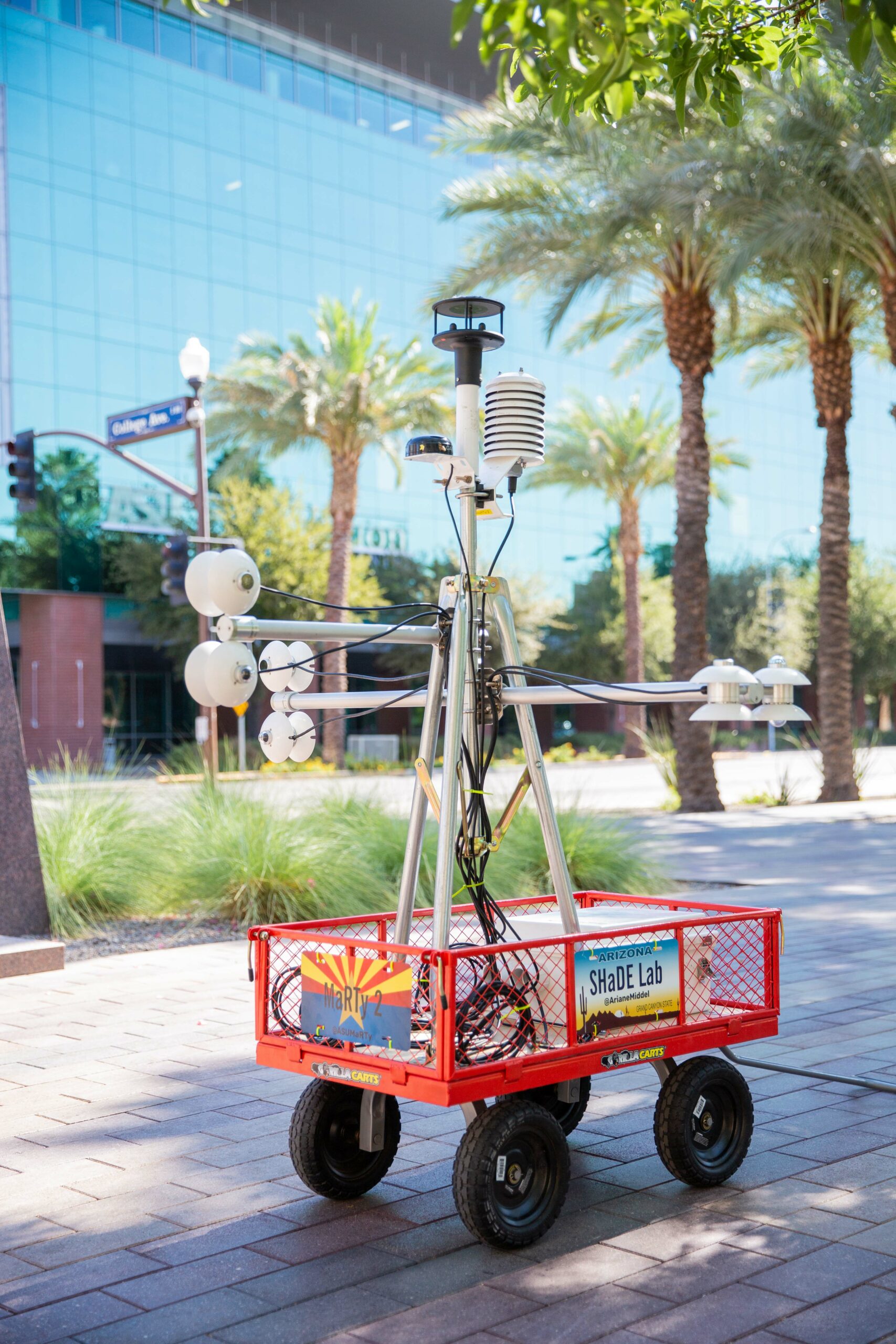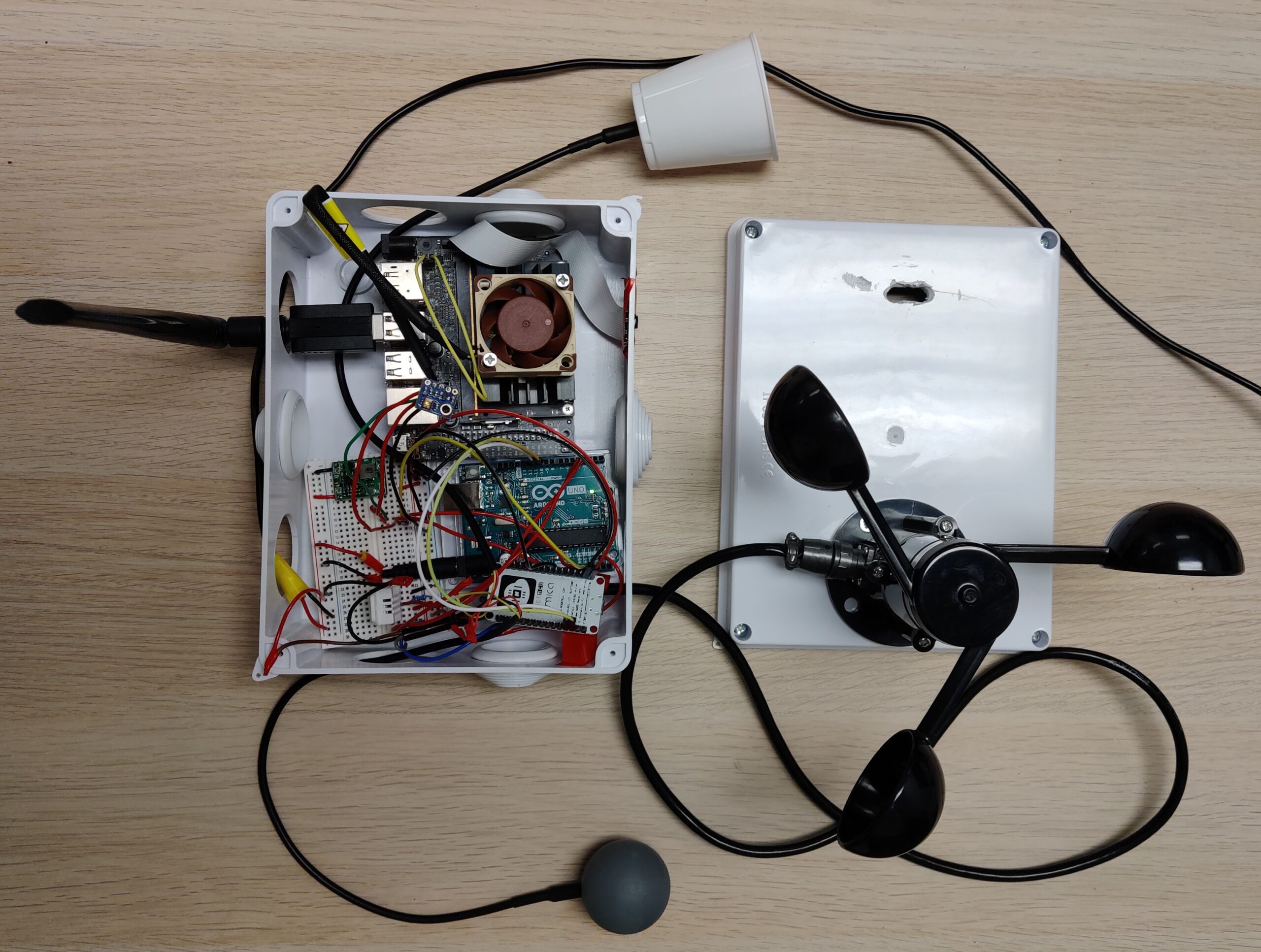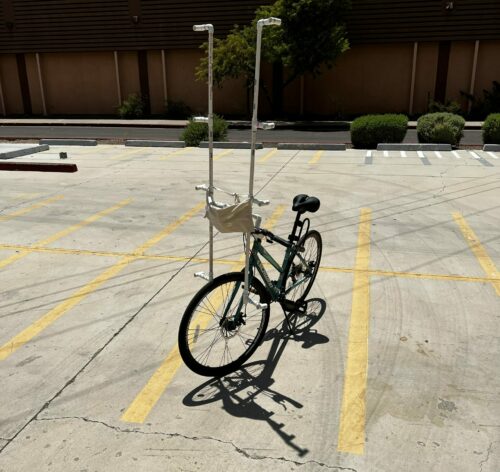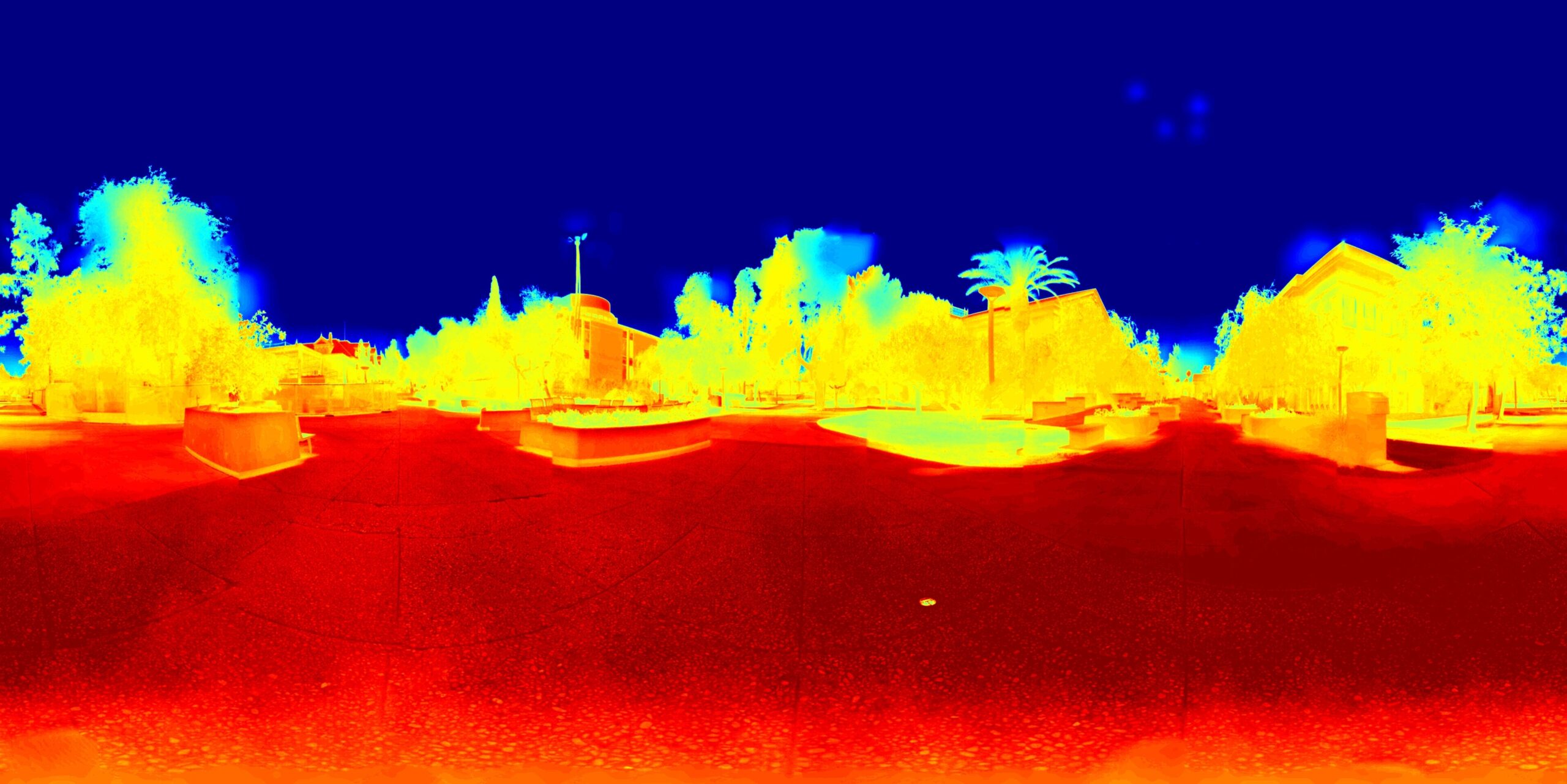Tools

MaRTy
MaRTy is a mobile biometeorological instrument platform that measures air temperature, humidity, wind speed and direction, GPS coordinates, and MRT (Mean Radiant Temperature) using the 6-directional method.
Learn how to assemble and operate MaRTy by watching this Playlist of instructional videos:
Publications with MaRTy
Coleman Merchant, Forrest Meggers, Miaomiao Hou, Dorit Aviv, Florian A. Schneider, Ariane Middel. (2022). Resolving radiant: Combining spatially resolved longwave and shortwave measurements to improve the understanding of radiant heat flux reflections and heterogeneity, Frontiers in Sustainable Cities, 4:869743. https://doi.org/10.3389/frsc.2022.86974
Yuliya Dzyuban, David M. Hondula, Jennifer K. Vanos, Ariane Middel, Paul J. Coseo, Evan R. Kuras, Charles L. Redman. (2022). Evidence of alliesthesia during a neighborhood thermal walk in a hot and dry city, Science of the Total Environment, 834: 155294. https://dx.doi.org/10.1016/j.scitotenv.2022.155294
Karthik Kashinath Kulkarni, Florian A. Schneider, Tejaswi Gowda, Suren Jayasuriya, Ariane Middel. (2022). MaRTiny – A low cost thermal sensing device, Frontiers in Environmental Science, 10:866240. https://dx.doi.org/10.3389/fenvs.2022.866240
V. Kelly Turner, Morgan L. Rogers, Yujia Zhang, Ariane Middel, Florian A. Schneider, Jonathan P. Ocón, Megs Seeley, John J. Dialesandro. (2022). More than surface temperature: Mitigating thermal exposure in hyper-local land systems, Journal of Land Use Science, 17(1):79–99. https://doi.org/10.1080/1747423X.2021.2015003
Ariane Middel, Saud AlKhaled, Florian A. Schneider, Björn Hagen, Paul Coseo. (2021). 50 Grades of Shade. Bulletin of the American Meteorological Society (BAMS), 102(9):E1805–E1820. https://doi.org/10.1175/BAMS-D-20-0193.1
Dorit Aviv, Hongshan Guo, Ariane Middel, Forrest Meggers. (2021). Evaluating radiant heat in an outdoor urban environment: Resolving spatial and temporal variations with two sensing platforms and data-driven simulation, Urban Climate, 35:100745. https://doi.org/10.1016/j.uclim.2020.100745
Peter Crank, Ariane Middel, Melissa Wagner, Dani Hoots, Martin Smith, Anthony J. Brazel. (2020). Validation of seasonal mean radiant temperature simulations in hot arid urban climate, Science of the Total Environment, 141392. https://doi.org/10.1016/j.scitotenv.2020.141392
Ariane Middel, V. Kelly Turner, Florian A. Schneider, Yujia Zhang, Matthew Stiller. (2020). Solar reflective pavement – A policy panacea to heat mitigation? Environmental Research Letters, 15:064016. https://doi.org/10.1088/1748-9326/ab87d4
Ariane Middel, E. Scott Krayenhoff. (2019). Micrometeorological determinants of pedestrian thermal exposure during record-breaking heat in Tempe, Arizona: Introducing the MaRTy observational platform, Science of the Total Environment, 687:137–151. https://doi.org/10.1016/j.scitotenv.2019.06.085

MaRTiny
MaRTiny is MaRTy's tiny sibling: a low-cost IoT biometeorological sensing device with embedded computer vision (patent pending).
MaRTinies will be deployed in City of Tempe parks (2021-2023) to investigate how the use of public spaces changes with the heat.
Publications
Karthik Kashinath Kulkarni, Florian A. Schneider, Tejaswi Gowda, Suren Jayasuriya, Ariane Middel. (2022). MaRTiny – A low cost thermal sensing device, Frontiers in Environmental Science, 10:866240. https://dx.doi.org/10.3389/fenvs.2022.866240

Micrometeorological Bike
This bike features fast response, high accuracy air temperature sensors at 4 heights and a surface temperature sensor. It was developed by Zachary Van Tol to assess the cooling impact of cool pavement in the City of Phoenix.
Ongoing Projects
Assessment of Cool Pavement in the City of Phoenix (2020-2023)


Thermal Imagery
Thermal cameras provide insight into “invisible” thermal properties of objects.
The FLIR E85 thermal camera measures surface temperatures with a 384 x 288 true native resolution. It has been used to visualize the cooling impact of murals that were created with "cool paint" and to demonstrate the difference between surface temperatures of regular asphalt concrete and "Cool Seal".
The FLIR Duo Pro is a thermal camera for drones that can take thermal panoramas when mounted on a rotating arm.
Past and Ongoing Projects
PanoMRT
Cool Art (UCLA, 2020)
Arterial Walls (City of Tempe, 2019)

Kestrel Heat Stress Trackers
The handheld Kestrel meter measures Wet Bulb Globe Temperature (WBGT) and Globe Temperature – an important metric for thermal comfort studies.
Publications using Globe Thermometers
Karthik Kashinath Kulkarni, Florian A. Schneider, Tejaswi Gowda, Suren Jayasuriya, Ariane Middel. (2022). MaRTiny – A low cost thermal sensing device, Frontiers in Environmental Science, 10:866240. https://dx.doi.org/10.3389/fenvs.2022.866240
Dragan Milošević, Ariane Middel, Stevan Savić, Kevin Lau, Jelena Dunjić, Rastislav Stojsavljević. (2022). Meteorological conditions and mask wearing behavior in urban spaces of Novi Sad in hot weather during the COVID-19 pandemic, Science of the Total Environment, 815:152782. https://doi.org/10.1016/j.scitotenv.2021.152782
Jennifer K. Vanos, Mary Wright, Ariane Middel, Alaina Kaiser, Harrison Ambrose, David M. Hondula. (2022). Evaporative misters for urban cooling and comfort: effectiveness and motivations for use, International Journal of Biometeorology, 66:357–369. https://doi.org/10.1007/s00484-020-02056-y
Jennifer K. Vanos, Konrad Rykaczewski, Ariane Middel, Daniel J. Vecellio, Robert D. Brown, Terry J. Gillespie. (2021). Improved methods for estimating mean radiant temperature in hot and sunny outdoor settings. International Journal of Biometeorology, 65:967–983. https://doi.org/10.1007/s00484-021-02131-y
Peter Crank, Ariane Middel, Melissa Wagner, Dani Hoots, Martin Smith, Anthony J. Brazel. (2020). Validation of seasonal mean radiant temperature simulations in hot arid urban climate, Science of the Total Environment, 141392. https://doi.org/10.1016/j.scitotenv.2020.141392
Kaylee Colter, Ariane Middel, Chris A. Martin. (2019). Effects of natural and artificial shade on human thermal comfort in Phoenix, Arizona, USA, Urban Forestry and Urban Greening, 44:126429. https://doi.org/10.1016/j.ufug.2019.126429
Mehdi Aminipouri, David Rayner, Fredrik Lindberg, Sofia Thorsson, Anders Jensen Knudby, Kirsten Zickfeld, Ariane Middel, E. Scott Krayenhoff. (2019). Urban tree planting to maintain outdoor thermal comfort under climate change: The case of Vancouver's local climate zones. Building and Environment, 158, 226–236. https://doi.org/10.1016/j.buildenv.2019.05.022
Mehdi Aminipouri, Anders Jensen Knudby, E. Scott Krayenhoff, Kirsten Zickfeld, Ariane Middel. (2019). Modelling the impact of increased street tree cover on mean radiant temperature across Vancouver’s local climate zones. Urban Forestry and Urban Greening, 39:9–17. https://doi.org/10.1016/j.ufug.2019.01.016
Ariane Middel, Nancy Selover, Björn Hagen, Nalini Chhetri. (2016). Impact of Shade on Outdoor Thermal Comfort - A Seasonal Field Study in Tempe, Arizona, International Journal of Biometeorology, 60(12):1849–1861. https://doi.org/10.1007/s00484-016-1172-5
Katherine Crewe, Anthony J. Brazel, Ariane Middel. (2016). Desert New Urbanism: Testing for Comfort in Downtown Tempe Arizona, Journal of Urban Design, 21(6):746–763. https://doi.org/10.1080/13574809.2016.1187558

ENVI-met
The computational fluid dynamics model ENVI-met is widely used to simulate neighborhood outdoor microclimate.
Publications using ENVI-met
Peter Crank, Ariane Middel, Melissa Wagner, Dani Hoots, Martin Smith, Anthony J. Brazel. (2020). Validation of seasonal mean radiant temperature simulations in hot arid urban climate, Science of the Total Environment, 141392. https://doi.org/10.1016/j.scitotenv.2020.141392
Mehdi P. Heris, Ariane Middel, Brian H. Muller. (2020). Impacts of form and design policies on urban microclimate: Assessment of zoning and design guideline choices in urban redevelopment projects, Landscape and Urban Planning, 202:103870. https://doi.org/10.1016/j.landurbplan.2020.103870
Fanhua Kong, Changfeng Sun; Fengfeng Liu; Haiwei Yin, Fei Jiang, Yingixa Pu, Gina Cavan, Cynthia Skelhorn, Ariane Middel, Iryna Dronova. (2016). Energy saving potential of fragmented green spaces due to their temperature regulating ecosystem services in the summer, Applied Energy, 183:1428–1440. https://doi.org/10.1016/j.apenergy.2016.09.070
Ariane Middel, Nalini Chhetri, Ray Quay. (2015). Urban Forestry and Cool Roofs: Assessment of Heat Mitigation Strategies in Phoenix Residential Neighborhoods, Urban Forestry and Urban Greening, 14(1):178–186. https://doi.org/10.1016/j.ufug.2014.09.010
Ariane Middel, Kathrin Häb, Anthony J. Brazel, Chris Martin, Subhrajit Guhathakurta. (2014). Impact of Urban Form and Design on Mid-Afternoon Microclimate in Phoenix Local Climate Zones, Landscape and Urban Planning, 122:16–28. https://doi.org/10.1016/j.landurbplan.2013.11.004
Data

Street View Segmentations
Deep Learning was used to extract spherical surface type fractions (buildings, impervious and pervious surfaces, trees, sky, non-permanent objects) from Street View images. A visualization of the data set can be found here. Please allow some time to load the visualization.
Data will be available for download soon.
Projects
ICARUS
Sky View Factor Footprints
WUDAPT
OpenMRT
Publications
Jason Ching et al. (2019). Pathway using WUDAPT’s Digital Synthetic City tool towards generating urban canopy parameters for multi-scale urban atmospheric modeling, Urban Climate, 28. https://doi.org/10.1016/j.uclim.2019.100459
Matthias Demuzere, Benjamin Bechtel, Ariane Middel, Gerald Mills. (2019). Mapping Europe into Local Climate Zones, PLoS ONE, 14(4): e0214474. https://doi.org/10.1371/journal.pone.0214474
Yujia Zhang, Ariane Middel, Billie L. Turner II. (2019). Evaluating the Effects of Vertical Urban Forms on Neighborhood Land Surface Temperature Using Google Street View Images. Landscape Ecology, 34(3), 681–697. https://doi.org/10.1007/s10980-019-00794-y
Ariane Middel, Jonas Lukasczyk, Sophie Zakrzewski, Michael Arnold, Ross Maciejewski. (2019). Urban Form and Composition of Street Canyons: A Human-Centric Big Data and Deep Learning Approach, Landscape and Urban Planning, 183:122–132. https://doi.org/10.1016/j.landurbplan.2018.12.001
Benjamin Bechtel et al. (2019). Generating WUDAPT Level 0 data – current status of production and evaluation. Urban Climate, 27:24-45. https://doi.org/10.1016/j.uclim.2018.10.001
Ariane Middel, Jonas Lukasczyk, Ross Maciejewski, Matthias Demuzere, Matthias Roth. (2018). Sky View Factor Footprints for Urban Climate Modeling, Urban Climate, 25:120–134. https://doi.org/10.1016/j.uclim.2018.05.004
Ariane Middel, Jonas Lukasczyk, Ross Maciejewski. (2017). Sky View Factors from Synthetic Fisheye Photos for Thermal Comfort Routing – A Case Study in Phoenix, Arizona, Urban Planning, 2(1):19–30. https://doi.org/10.17645/up.v2i1.855

